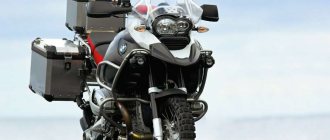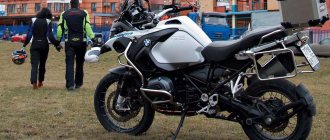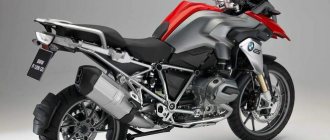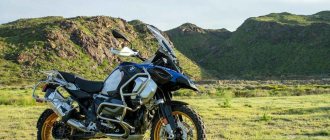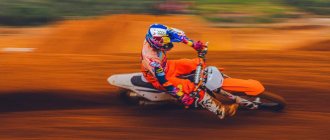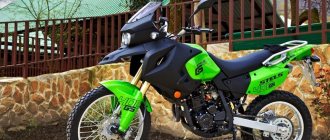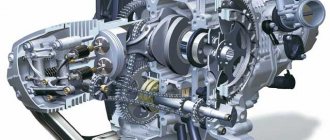Choosing a used BMW R1200GS
SWAN GEESE. Having appeared in 2004, the current generation of GSs changed a little only in 2010: they received an updated overhead motor (+5 hp), but otherwise the “goose” remained the same. Today there are more than 980 thousand species of birds in nature. As for the “geese,” only four species have been described recently: the junior F650GS, the mid-size F800GS, the senior R1200GS and its Adventure modification. We will talk about the “kids” another time, but now we will talk about the older opposite “geese”. “Adventure” differs from the usual one in the gas tank increased from 20 to 33 liters (which ensures a non-stop flight of up to 500 km), spoked rather than cast wheels, the presence of a tubular “cage” around the engine, as well as more developed wind protection. Other options (such as “electric” ESA suspensions, tire pressure sensors, heating, ABS and a great variety of external gadgets) are available on both models. So, after all, what should you look for when choosing, so that the external gloss and abundance of tuning do not mask the overall shabbiness of the car, or vice versa, so that the lack of “minced meat” does not deceive a “living” motorcycle in a new state?
BIRD'S HEART. In principle, the engine is indestructible: if it is not overheated and the oil is changed on time, it can easily survive two hundred thousand kilometers. However, even the pillars of reliability have weak points, and in this case, one is due to the layout - needless to say, the opposed engine is more afraid of falls than other motors hidden in the depths of the frame. There is no frame as such, and the cylinders stick out defiantly to the sides. Therefore, the first thing you should pay attention to when inspecting the engine is the virginity of the edges of the bolts, the absence of oil stains at the joints between the crankcase, cylinders and heads, and the external “knots” on the “pots”. When you listen to the engine, do not forget that even though it is noisy and “ventilated,” rhythmic metallic knocks equally hint at a diagnosis for any engine, regardless of the type of cooling.
As for the transmission, there are two weak points: the clutch and the rear tip. The clutch here is single-plate dry - like on cars, and it is just as easy to burn it - just a few “racing” starts from traffic lights at high speeds, and the characteristic smell of a scorched disk will not take long to appear. And if the clutch can somehow be diagnosed (it should not slip when the gas is sharply opened in higher gears), then the rear gearbox is unrealistic. The problem is that motorcycles manufactured before July 2006 suffer from the fact that in some cases the rear wheel hub bearing separator and, accordingly, the driven gear of the final drive suddenly fall apart. As a rule, the gears are chewed even before the owner notices something is wrong. This usually happens after a mileage of 20–30 thousand kilometers. For reference, the cost of rebuilding the “bridge” is about 15 kilo rubles, the assembled gearbox costs about a “ton” of euros. Someone will probably suggest shaking the rear wheel when it is hanging, but you will hardly be able to notice the play - the bearing dies instantly, without any symptoms. So it’s better to look for a newer car, or take a “goose” with an already replaced “bridge”.
HOW'S FEET. This is not a cake. This is the chassis. Everything here is as simple as it is atypical. Firstly, the main load-bearing element of a motorcycle is the motor. And the whole “hanging” is attached to it on tubular stretchers. Their integrity and straightness can be checked both by eye, placing the motorcycle on the center stand, and on the move, releasing the steering wheel on level asphalt: the motorcycle should stand and ride perfectly straight, it should not be led to the side, but the “tail” and the rear wheel should not be displaced relative to each other. In “adventure” vehicles, it is also worth inspecting the steel protective frame that encircles the engine for dents. In my memory, there was one “goose” whose engine was torn from the box after the frame hit a pine tree.
As for the suspensions, in addition to the integrity of the chrome on the fork stays and monoshock rods and the absence of oil stains on them, be sure to check the operation of the ESA system, if there is one - following the graphical display of the state of the shock absorbers, the suspensions should switch modes quickly, their change is noticeable by the change in the nature of behavior motorcycle. But there is hardly any need to be afraid of the current telelever feather seals - they are no more difficult to move than a classic fork design. It would be a good idea to check the ball joint of the lower yoke for play by hanging the front wheel and tugging the lower ends of the stays back and forth.
SUMMARY. Here, in fact, are all the nuances of choosing, perhaps, the most convenient enduro for travel. And in order for the “goose” to serve faithfully for a long time, you should monitor the cleanliness of the oil cooler, adjust the valve clearances in a timely manner, do not increase the interval for replacing consumables such as oil, filters, spark plugs, do not feed it with 76 gasoline and do not play traffic light races with sport bikers. And as for tuning, the “Golda” will be jealous of the abundance of all kinds of gadgets.
In popular culture
In 2004, the R1150GS adventure model of BMW's previous series of twin-engine boxer bikes was used by Ewan McGregor and Charley Boorman for an epic motorcycle journey from London to New York via
Europe, Asia and Alaska;
and this adventure was in the book and television series "The Long Way Around". In 2007, the same couple used an R1200GS Adventure BMW to continue their journey from John O'Groats in Scotland to Cape Agulhas in South Africa, [22]
this project was documented in
Long Way Down
.
R1200GS appeared in several episodes
BBC Two television program The Hairy Bikers' Cookbook
, ridden by chefs Dave Myers and Sea King.
Renowned motorcyclist journalist Kevin Ash died from his injuries. Injured in an accident while test riding the R1200GS during its press launch in 2013. The investigation determined that death was the result of an accident. But the British coroner could not give the full reasons
- ^ a b c
- ^ a b
(PDF).
BMW Motorrad. Retrieved February 18, 2010.[ permanent dead link
] - ^ a b
. BMW Motorrad. Archived from the original on May 5, 2022. Retrieved March 23, 2013. - . Telegraph. July 19, 2012. Retrieved August 18, 2012.
- Ash, Kevin (February 14, 2007). . Archived from the original on February 10, 2009. Retrieved 2009-01-07.
- . Motorcycle News. May 20, 2005. Archived from the original on February 10, 2009. Retrieved 2009-01-08.
- . October 29, 2005. Archived from the original on February 11, 2009. Retrieved 2009-01-08.
- . American Motorcycle Association
. July 13, 2006. Archived from the original on September 28, 2007. Retrieved 2007-08-31. - Kevin Ash, BMW ASC traction control
, archived from the original on January 17, 2010. Restored 2010-01-03 - . webBikeWorld. November 5, 2009. Retrieved December 15, 2009.
- Dirck Edge (October 2, 2012). . Motorcycle Daily. Retrieved 2013-01-24.
- ^ a b
. Motorcycle-usa.com, Bart Madson, January 30, 2013. - . Motorcycle.com, Kevin Duke, Ian. 29, 2013.
- . Canada Moto Guide, ZAC KURYLYK, March 5, 2013.
- . Motorcycle.com, 03/04/2013, Dennis Chang.
- . webBikeWorld (from BMW press release)
. August 3, 2007. Retrieved 2009-02-03. - ^ a b
Ash, Kevin (February 2, 2007). . Archived from the original on February 10, 2009. Retrieved 2009-01-07. - . motorcycle.com January 22, 2009. Archived from the original on January 25, 2009. Retrieved February 2, 2009.
- Steve Anderson (May 2012), Cycle World
, [T]he BMW R1200GS...the most successful motorcycle of the last two and a half decades. It sells so well. What represents a very significant piece of BMW production was the car. Which she created. This continues to define the category of adventure tourism. - . www.socalbmwmc.com
. restored 2017-10-08. - Rainer. Volume (May 4, 2007). . Motorcycle News. Archived from the original on December 20, 2008. Retrieved 2008-12-28.
- . BMW World. May 31, 2006. Archived from the original on February 11, 2009. Retrieved 2009-01-09.
- Welch, Andy (August 18, 2008). . Manchester Evening News. Retrieved 2009-01-09.
- Coroner's inquest
Tightening torque bmw r1200gs
in general, subj speaks for itself. While the goose stood with the rear axle untwisted waiting for the ordered parts to arrive, I decided to service everything else:
1) bleed the clutch. The clutch on the goose is the easiest to pump, you just need a special fluid 21520392546 (vitamol\hyspin V10) the essence of the work is to attach the tube to the fitting, unscrew it a little, slowly work the clutch lever, constantly adding fluid to the reservoir so as not to suck in air. We do this until a new “blue” liquid flows out of the tube. this will take about a third of the jar
2) replaced the rear pads. nothing complicated, carefully unscrew the rear caliper, knock out the pin, install the pads, hammer in the pin, screw on the caliper. installed FERODO FDB2039ST.
3) I decided to change the oil in the box, unscrewed the filler plug, dipped my finger - it was as clean as a child’s tear. left it as is.
4) the engine oil also seems to have been changed recently, but since the can and filter had already been purchased, I drained everything and replaced it. I filled it with Motul 7100 20w-50, filter MAHLE OC306 mileage 22261, so as not to forget.
5) ordered and installed a headlight protection kit. number 63127695770. It’s expensive, now I doubt whether it was necessary to do this. it takes 5 minutes, nothing interesting
7) replaced the fluid in the front brake circuit. This turned out to be a hemorrhagic issue for BMW, I recommend thoroughly studying the articles on replacing fluid in the RSD help system before starting. I started without studying it, and ended up stuck with 4 hours of work instead of 1. In short, first you need to remove the tank. then, connecting to the fittings of the ABS block, strictly according to the manual, pump the circuit from the lever to the ABS, and then from the ABS to the pads. The usual classical method of bleeding “from the lever to the pads” does not work, because BMW...
and now the slides! It stayed like this for a week while I was waiting for spare parts for the rear flange:
It stayed like this for a week while I was waiting for spare parts for the rear flange:
headlight protection kit:
rear pads are different
oil cooler BEFORE and AFTER
clutch and its blue liquid, it was previously called VITAMOL V10, now Hyspin V10
Bmw r1200gs 2006 manual
The BMW R1200GS and R1200GS Adventure are motorcycles manufactured in Berlin, Germany by BMW Motorrad, a member of the BMW group. This is one of the BMW GS family of dual-sport motorcycles. Both motorcycles have 1170 cc. cm (71 cu in), two-cylinder boxer engine with 4 valves per cylinder. The Adventure has a larger fuel tank and longer travel suspension. As of 2012, BMW R1200GS bicycles are their best-selling models.
Content
At its launch in 2004, the R1200GS was 30 kg (66 lb) lighter than the R1150GS. Which he replaced [5]. and produced 100 liters. With. (75 kW). An increase of 19%. BMW continued to produce the R1150GS Adventure. By releasing a special edition model [6]. before the launch of the R1200GS Adventure in late 2005. For 2006 model year. [7]
Modernization for the 2008 model year included an increase in power to 78 kW (105 hp). Release of a new integrated
anti-lock braking system ABS II without servo assistance and adding new options. Including Electronic Suspension Adjustment (ESA) and Automatic Stability Control (ASC). [8] [9]
For the 2010 model year, both models featured a revised DOHC cylinder head. Increased redline limit to 8500 rpm and exhaust flap. To give the exhaust a different tone. Power is increased to 82 kW (110 hp) at 7,750 rpm. [10]
At the 2012 Intermot show, BMW announced that the 2013 model will have
water-cooled, produce an additional 11 kW (15 hp) and weigh approximately 9.1 kg (20 lb) more. Than the outgoing model. [eleven]
Although the 2013 model has since proven itself. She had a somewhat shaky start. In the UK the R1200GS was subject to various DVSA vehicle recalls covering front brakes, anti-lock braking system, throttle cable. Fuel pump, clutch. Final drive unit. Brake pipes and gearbox; [12] [ minor source required
] and similar reviews were issued in other countries.
early journalistic reports described the motorcycle as having front-end speed fluctuations, [13] [14] and deliveries of the motorcycle were stopped. While BMW has revised the front end geometry. [15] [16]
There were annual incremental updates during the 2014 to 2016 model years. Including adjustments to road handling and the addition of such options. Like LED headlights. Keyless ignition. Quick gear shift. Anti-theft system and another lower seat option. New ABS mode available as a software update. Allows you to brake more safely when cornering.
For the 2022 model year, the bike was restyled with technical changes in accordance with European EU4 regulations. Side reflectors and an on-board diagnostic display (OBD) in the cockpit were added. Indicating a malfunction. So is the R1200GS Adventure. All liquid-cooled Boxer models were equipped with a damper on the transmission output shaft. The selector drum drive, transmission shafts and transmission shaft bearing have been revised. The GS also received a new crash bar option, allowing the installation of protective cylinder covers. As was standard on Adventure.
As of 2007, the R1200GS was BMW's best-selling motorcycle. Exceeding 100,000 units. [17] In 2006, the R1200GS was the best-selling motorcycle in the United Kingdom. With cumulative sales of 2,227 units. The next most popular motorcycle, the Honda Fireblade, sold 2,067 units. [18]
Almost a third of the 100,000 units sold by BMW Motorrad worldwide in 2006 were R1200GS. [18]
In 2008, the R1200GS again became BMW's best-selling motorcycle. Delivering 22,845 standard models and 12,460 adventure models. [19]
In 2012 Cycle World
named the R1200GS in the adventure touring category. [20]
As of December 2016, 145,032 motorcycles and maxi-scooters had been sold. Sales of BMW Motorrad vehicles increased by approximately 50% compared to the 98,047 vehicles sold in 2010. The R series represented more than half (53.6%) of all BMW motorcycles sold in 2016. Around 17% of BMW Motorrad bikes sold in 2016 were BMW R1200GS, with an increase of 7% compared to 2015.
The R1200GS Adventure sold 21,391 units (up 18.8%). And R1200RT-9 648 units. [21]
In popular culture
R1200GS appeared in several episodes
Renowned motorcyclist journalist Kevin Ash died from his injuries. Injured in an accident while test riding the R1200GS during its press launch in 2013. The investigation determined that death was the result of an accident. But the British coroner could not give full reasons [13] [25]
MY MOTORCYCLE
This year, BMW presented an interesting new product for fans of the brand and fans of motorcycle travel, which will leave few people indifferent - the BMW R1200GS Adventure.
Outwardly, it looks almost exactly like the base model, but some details immediately give it away as a real “wanderer” - it’s hard not to notice the additional equipment weighing almost 30 kilograms with which this bike is hung.
But the question remains - why did marketers decide to build the GS Adventure, essentially a competitor to the usual “goose” - the R1200GS has been in production for thirty years and is one of the company’s most popular motorcycles, why create something different?
The answer is simple - they aimed this motorcycle at those who like things bigger than others and are willing to pay for them. These are the type of people who like huge jeeps and stuff like that. But in order to make him fork out the cash, the engineers of the German company had to really work hard, because no one will pay just for a cool appearance!
Most of the modification components of the bike remain from the regular GS. The engine has undergone major changes - the two-cylinder boxer Boxer engine with air-liquid cooling has become 15 horsepower more powerful than its predecessor. (The same power unit is also used on the BMW R1200RT motorcycle.) It also received a new frame, installed a driveshaft on the left side, equipped the motorcycle with semi-active suspension and Brembo brakes, and how could it be done without additional accessories.
What differences can we see externally?
Externally, the Adventure version has serious differences from the basic GS modification. First of all, these are powerful protective arches that cover the motor and plastic housing. As options, the motorcycle can also be equipped with plastic hand protection, a reinforced adjustable brake pad and wide footpegs. The regular spoked wheels are wrapped in stock Continental TKC off-road tires, although most buyers prefer street tires. Why not go off-road, it’s such an adrenaline rush. Of course, one cannot fail to note the windshield, which perfectly protects the driver from the air flow, and a set of aluminum panniers.
As for the changes inside (such as in the engine, etc.), the engineers installed a more massive crankshaft, which produces 20% more inertia, and, accordingly, an increased flywheel effect. Ride-by-wire electronics - two new ignition maps have been integrated for off-road driving.
The working stroke of the suspension shock absorbers was increased by 20 mm. Raising the suspension added a couple more tasks - to compensate for the enthusiastic ride, the engineers had to slightly change the geometry of the steering wheel and install a damper on the driveshaft, in which vibrations appeared. And the most noticeable change in the design of the BMW R1200GS Adventure is, of course, the fuel tank; its volume has increased to 36 liters, which, with a consumption of 5-6 liters per hundred, puts this motorcycle in the category of the longest-range. This is very helpful when you are far from civilization.
Thanks to tuning, the bike has gained “mass,” as the jocks like to say - the curb weight of the BMW R1200GS Adventure is 260 kg, and together with panniers it exceeds 270. But this does not prevent it from superbly obeying the steering wheel and having excellent balance, it has been “pumped up” perfectly. )))))
The heavier crankshaft shows itself to a greater extent on roads with poor surfaces, thanks to it the engine has become more torquey at low speeds. By the way, engineers have developed two new ignition maps for the GS Adventure - Enduro and Enduro Pro - specifically for driving through difficult areas. The remaining engine operating modes - Rain, Road and Dynamic - are exactly the same as on a regular “goose”. The operation of other systems is also adjusted to the selected mode - stability control, anti-lock braking system and semi-active suspension.
Interestingly, the Enduro Pro mode has special settings for riding on toothy off-road tires. Its peculiarity is that the ABS on the rear wheel is turned off, while the anti-lock braking system on the front wheel continues to work. This is a real find for experienced riders who, thanks to Enduro Pro, have the opportunity to drift not only on a sports track, but also where there are no roads. and there are enough such pros now. Is it worth adding that in this mode the BMW R1200GS Adventure behaves almost like a motocross motorcycle? Cool too!! You can get rid of excessive agility by switching to Enduro mode. It is calibrated for regular road tires and is more forgiving than the Pro. Proprietary electronics allow the GS Adventure to instantly take on the role that seems necessary to the rider. Wide and smooth highway? Great - Road mode will instantly turn this bike into a full-fledged cruiser. Broken track? - no problem, turn on the Enduro mode and the cruiser immediately takes on the character of a cross-bike. Do you want a thrill? — Dynamic mode will turn a BMW into a sports motorcycle. In short, they stuffed it and brought the bike almost to a station wagon, although the motorcycle was originally made for tourism.
Comfort is also available on the BMW R1200GS Adventure:
The wind fairing perfectly protects from headwinds, a comfortable soft seat and landing allow you to cover several hundred kilometers without a hint of fatigue and without stopping, an informative dashboard that tells the driver everything he needs to know during the trip - from the fuel level in the gas tank to the temperature ambient air. For those who like to discover new routes, there are mounts for a GPS navigator above the dashboard.
As a result, we can say that the Bavarians did a very good job and created an even more advanced motorcycle in which it is impossible to find any flaws. Although if we find fault, we won’t!)))))
One disadvantage of all this happiness on two wheels is the high price, but again it is aimed at those for whom the price tag does not matter.
https://youtu.be/s6Cpl7FA8Xc
2014 BMW R1200GS Adventure Specifications:
| Motor and drive | |
| engine's type | Opposed |
| Number of cycles | 4 |
| Volume | 1170.00 cm³ |
| Number of cylinders | 2 |
| Diameter*Stroke | 101.0 mm x 73.0 mm |
| Valves per cylinder | 4 |
| Compression ratio | 12.0:1 |
| Power | 125.00 l. With. @ 7750 rpm |
| Torque | 125.00 Nm @ 6500 rpm |
| Fuel system | Fuel injection |
| Cooling system | Air-liquid cooling |
| Ignition | Electronic ignition |
| Fuel control | DOHC |
| Clutch | Single disk. Dry |
| Transmission | 6-speed |
| Drive unit | Cardan |
| Exhaust system | Catalyst. Euro 3 |
| Fuel consumption | 4.60-6.10 l/100km |
| Maximum speed | 200 km/h |
| Chassis | |
| Frame | Two-piece frame (front and rear sections) supporting engine and gearbox |
| Front suspension | 41 mm BMW Telelever |
| Front suspension travel | 210 mm |
| Rear suspension | BMW Paralever. Aluminum |
| Rear suspension travel | 220 mm |
| Fork angle | 65.2 |
| Discs | Spoke |
| Front wheel size | 110/80-R19 |
| Rear wheel size | 150/70-R17 |
| Front brake | Disc, 2 discs, four-piston fixed calipers |
| Front brake diameter | 305 mm |
| Rear brake | Disc, 1 disc, two-piston floating caliper |
| Rear brake diameter | 265 mm |
| Weight and dimensions characteristics | |
| Length | 2240 mm |
| Width | 990 mm |
| Height | 1525 mm |
| Seat height | 890 mm |
| Wheelbase | 1510 mm |
| Dry weight | 225 kg |
| Curb weight | 259 kg |
| Power/weight ratio | 0.4247 |
| Gas tank capacity | 33.00 l |
| Reserve tank volume | 4.00 l |
kot_3axap
One day I wanted to have a motorcycle with a round headlight and splayed cylinders. After scouring the local market, I found three units for sale.
Two are in moderate condition and running (and therefore quite expensive), one is in an almost abandoned state and therefore cheaper. Well, after the auction he grabbed it.
Photos from the first meeting
Upon closer look, numerous schools began to emerge
04 Rust everywhere
05 The spokes are all rusty
08 Oil where it shouldn't be
09 Motsyk stood for a long time, but no puddles of oil appeared under him
11 The worst problem is the paint coming off everywhere. The photo shows the gearbox, the engine is even worse
12 There are traces of corrosion under the paint on the rear fork. The brake hose cover was missing and corrosion had started to spread from the mounting studs.
13 Condition of paint on the engine
14 Oil leaks from under the cylinder?
15 The insulation of the cable harnesses is crumbling
17 The tires looked almost new, but they were as old as the motorcycle itself
18 Rear fork corrosion
Also the rear fender is cracked on both sides.
Of course, upon inspection, starting it was not an option - the battery was dead. Therefore, having bargained even lower based on the results of the inspection, I took this trash. After transporting the unit home, I changed the oil and battery and took the risk of starting it up. It started, as they say, with half a turn. I drove about 100 miles (went to registration, talked to the mechanics, just drove around). It turned out that the left cylinder had some problems with chain tension (as I later discovered, this is a common problem with the model, for which the manufacturer produced a modified tensioner), and the compression on one cylinder was quite low, although within normal limits. It also did not work controls on the left console - turn signal, horn, high beam. After the rides I started disassembling.
This is my first motorcycle that I have taken apart. Well, breaking is not building, but I also wanted to put it back together later.
The main goal is to paint the engine. But the problem with this creation of the gloomy German genius is that the engine cannot simply be taken and removed from the frame, because that is what it is. Those. In order to “take out” the engine, you need to disassemble the bike completely, literally. Well, since such a disassembly, then immediately everything else that comes to hand will be painted.
I gave it to a local customizer for sandblasting and “painting” with powder; I ordered consumables and other spare parts from Germany.
I scoured the American forum dedicated to this model. I picked up all sorts of useful information there. I printed out the service manual. I came up with a plug with electrical diagrams - I couldn’t find it online, apparently they are highly classified. I had to order.
19 The fuel tank has been removed. This model does not have ABS; in its place is an alarm box.
20 Workbench for disassembly. There is no central footrest. The motorcycle was lifted with an electric winch suspended from a beam and left there so that it would not fall over during disassembly. I took off the wheels.
21 Brake pedal condition
22 The battery box is rusty.
23 The cable harness under the battery compartment looks terrible. The outer insulation was crumbling, but all the wiring, fortunately, was in good condition and did not require replacement.
24 Somehow, the photo turned out to be mirrored. Probably, I clicked in the wrong place when converting.
Probably, I clicked in the wrong place when converting.
25 Contents of an electrical box with all sorts of relays and connectors
26 The front suspension (telever or whatever it is called) has a strange aluminum plug on the left side, ground into a hexagon. As you can see from the photo, the hexagon turned out to be stronger. Without removing the cover, you cannot remove the axle.
27 A drill is a young mechanic’s best friend. The cover is drilled to the best of its ability (a new one has been ordered instead).
28 Injection lines - the rubber parts are all cracked; for the rides, before disassembling they had to be wrapped with electrical tape to isolate air leaks.
29 The fork has been disassembled, oil seals and boots have been ordered.
30 Dirt in the fork (the plastic tube is part of the design).
32 The front frame has been removed. The lumber in the background is pieces for another project completed at the same time (and much faster) - re-roofing a house
34 What a mess
35 Attaching the battery negative to ground
36 The location is very inconvenient. The pain naturally refused to come out and had to be drilled out.
37 The sensor connection looks completely unreliable, but I couldn’t find any information about whether the wire slipped off or someone’s thread
It's time to disassemble the engine.
38 First you need to dismantle the generator hanging on the front cover.
39 Box and clutch removed
40 Disassembling the box was not included in the plans, so I agreed to paint it not with powder, but with regular car paint - it cannot be left in this form.
41 Dry clutch, single disc
42 The engine is “removed” from the remains of the motorcycle
43 The chain on the left cylinder is sagging (not quite noticeable in the photo). A new tensioner with a modified design has been ordered.
44 Dismantling the cylinders.
45 Work is in full swing. Pay attention to the pin inserted into the hole in the flywheel on the left - it is necessary to hold the pistons at TDC. At the same time, I ordered a special device for this purpose, which fixes the flywheel through the teeth.
46 To prevent the piston from hitting the body, before removing the cylinder, I tied the pistons to the studs
47 I used electrical tape to mark how far the studs were screwed into the body, and then unscrewed them using two nuts
48 Synchronizer chain before dismantling
49 The TDC mark is tiny, but still noticeable.
50 Oil pump
51 Flywheel removed.
52 The pin for the side step spring broke off when trying to unscrew it. I cut a new one out of the bolt.
53 Bolt securing the protective frame around the cylinders. Some craftsman put it on glue. Moreover, as far as I understand, the hole initially has no thread. He tore off the head quite quickly, the sledgehammer did not help either when it was cold or when heated with a gas burner (he heated it carefully, without fanaticism, so that the body did not lead). In general, I had to drill it out, otherwise the crankcase would not be halved.
54 Drilling took two evenings (fiddling with the motor after work) and several broken drills.
55 Everything inside is clean, no defects were found. Disassembly of the crankshaft was not planned.
56 There are two large oil seals on the shaft.
57 The rest of the bolt had to be drilled out and knocked out
58 Disassembling the oil system.
60 Intake valve condition
61 I also planned to paint the exhaust pipe. However, I couldn’t unscrew the oxygen sensor. I warmed it up, and sprayed all sorts of garbage, and gnawed with a gas wrench - nothing. I left it like that for now, and had to try to polish the exhaust somehow.
62 oxygen sensor after trying to unscrew it
63 The wheels are painted (sandblasting, then powder), new tires are installed.
64 Front frame painted and assembled - refrigerators installed
65 I cleaned the piston of deposits. I measured the rings - within limits. I ordered a set of new rings.
66 Valves cleaned. After painting the heads, I gave them for grinding, so as not to mess around with them myself.

